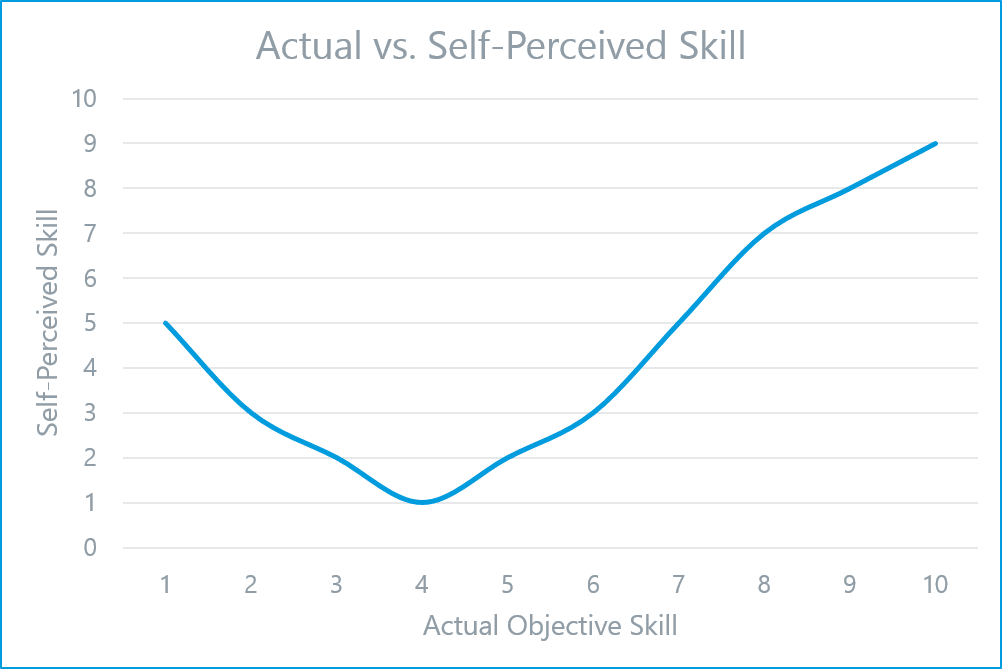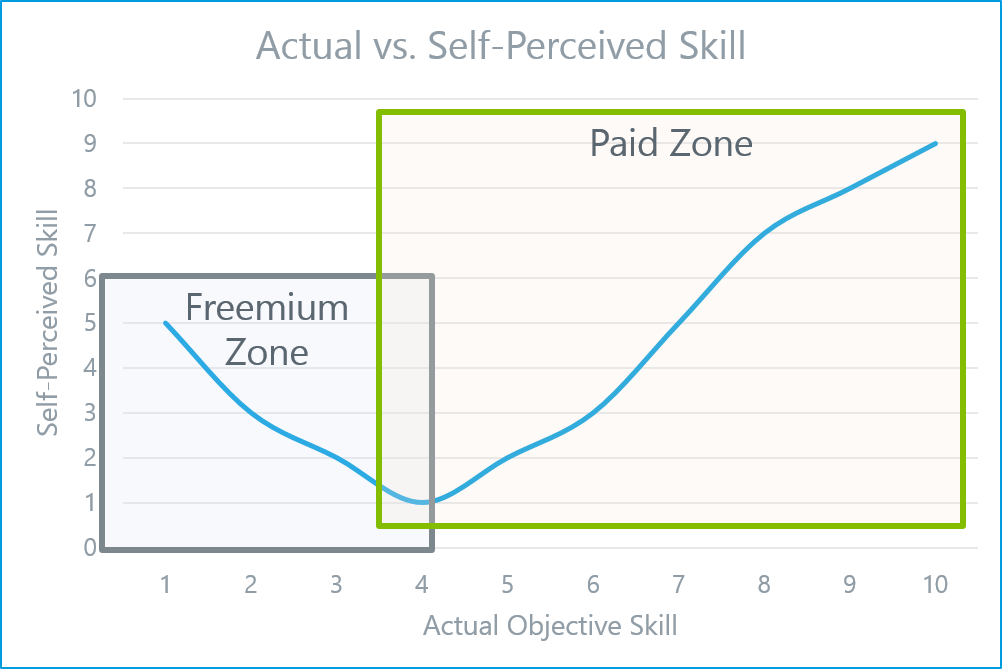"Why don't you offer a free trial version to get more customers, then work to convert to paid more efficiently?"
This question is inevitably asked by board members, investors, consultants and other advisers to technology firms as if the free trial/freemium model was a magic bullet that would solve all growth problems. Sometimes it can, but it is really important to understand why freemium works, what it drives in terms of customer perception, how it can be effective and when it really can lead to failure or revenue loss.
Before discussing the free vs. paid model, we first have to talk a bit about how humans behave in learning, particularly how their own self-perception changes over time in regards to a new area of information or knowledge.
The Dunning-Kruger effect is a model in psychology that was outlined in the 2000 research report titled "Unskilled and Unaware: How difficulties in recognizing one's own incompetence lead to inflated self-assessments". In this work, David Dunning and Justin Kruger examined the behavior of people who have very little actual skill in a series of common tasks (telling a joke, for example) and how their self-perception changed as they learned more about the skill.
What came out of it was an interesting graph, built across many different skill tests. In it, it showed that people with very little actual skill as measured by others rated themselves higher than their actual skill, but once they were exposed to the subject and learned more, paradoxically, their self-perception drops until they begin demonstrating some mastery of the subject and understanding of the gaps. Then, their actual skill and perceived skills align and they become skilled, as well as becoming aware of their skills in the area. Graphically, it plots out like this:

One of the major shifts that came about, with the leadership of Salesforce.com and others, was a significant shift in the model on how enterprise software is bought. What wasn't immediately obvious was how this shift took advantage of the Dunning-Kruger effect with such efficacy.
What SAAS companies did that was so different is they shifted the enterprise application sales model from how it has operated since the early days of IBM:
- Gather requirements from the customer
- Design the solution architecture and deployment
- Pilot the solution as a test of the fit
- Modify the solution from the pilot feedback
- Deploy and scale out the solution to all users
This approach worked well, but required IT to work on translating business requirements to IT directives and required a lot of business knowledge in advance on how they wanted the business to run prior to building the solution.
The SAAS approach was markedly different:
- Get a business user to trial the solution
- Adopt the solution as defined generically
- Learn where the generic model creates friction in your business
- Change the system through app enhancements from other vendors
- Learn more
- Change more
- Keep increasing customization over time to fit your business
Under this model, the business user could rapidly adopt a technology solution without IT oversight, roll it out and then, over time, seek out application vendors and service providers who can adapt, integrate and extend the generic solution into their custom solution, creating great fit for the business and stickiness for the vendors.
Underpinning this is the Dunning-Kruger effect - during the period of low information (trial and adoption), there is low risk - little trial costs (often free, except for the time of the business users learning the new tool) and lower internal costs - no IT resources are being consumed to design the solution. As the business users and owner of the application becomes more skilled in the capabilities and, more critically, the gaps in the experience, their knowledge on how to close the gaps becomes better. In short, the trial and adoption process matches both the economic risks and the personal self-perception risks of the buyer much better than traditional IT sales models, which require high knowledge in advance on the business requirements for the application.
As a result, there is a model for where to place trial and when to monetize that maps to the actual and self-perceived skills of the buyer:

Once you understand the role of Freemium or Trialware in context of the Dunning-Kruger effect, it's helpful to examine situations where trialware actually can harm your business. In cases where the current knowledge of the buyer is high relative to the product features, trialware can drive broad adoption, but low monetization relative to actual use. An example of this is any product that can be used in a transactional way, like a file format converter – once the transaction is complete there is little additional value to be gained.
The trick to an effective freemium model is to ensure the features of the free or trial version draw the user into a good experience that results in increasing competence with the product. This often means hiding features with a high learning curve or narrow use case, simplifying menus to raise the speed of adoption or other methods to ensure the sense of self-perceived skills is aligned with actual skill as quickly in the trial process as possible. Once the buyer feels they understand the service and its capabilities, only then will they progress to expanding the use and higher monetization.
Freemium works, but only if it helps educate your buyers into being confident enough to buy the service and you approach the freemium process as a way to grow with your buyers skills. The Spur Group can help you determine the free to fee model for acquiring and converting customers into paying customers through our Go To Market strategy practice. Give us a call to discuss your Freemium strategy and how to make it work to win share for your business.

